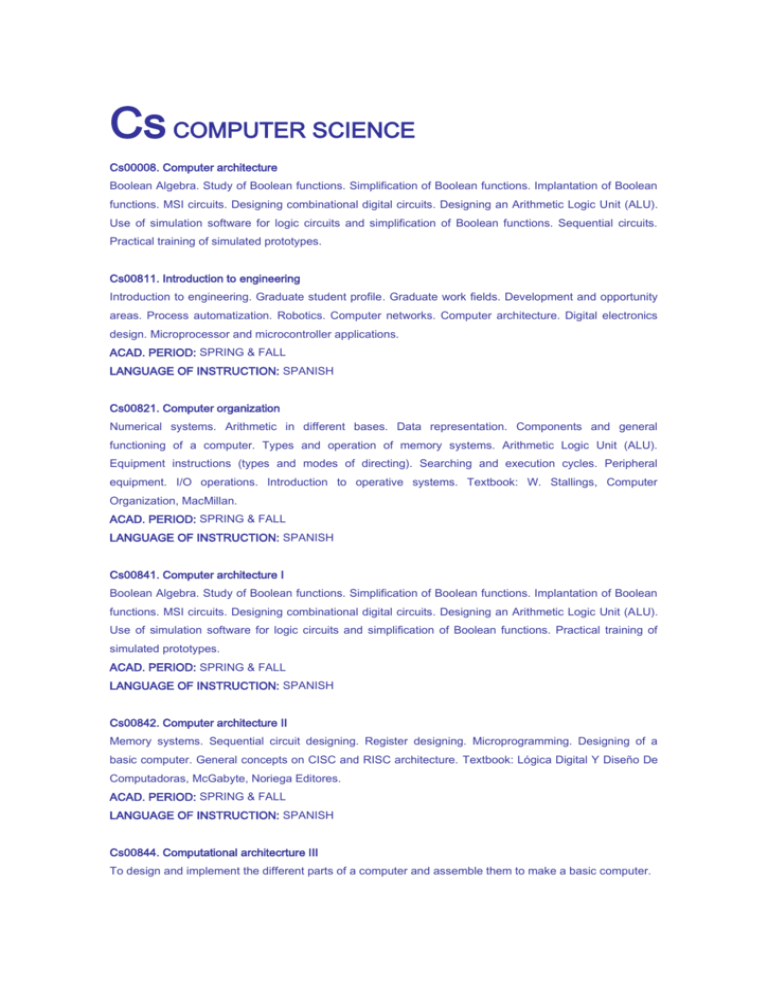Cs COMPUTER SCIENCE
advertisement

Cs COMPUTER SCIENCE Cs00008. Computer architecture Boolean Algebra. Study of Boolean functions. Simplification of Boolean functions. Implantation of Boolean functions. MSI circuits. Designing combinational digital circuits. Designing an Arithmetic Logic Unit (ALU). Use of simulation software for logic circuits and simplification of Boolean functions. Sequential circuits. Practical training of simulated prototypes. Cs00811. Introduction to engineering Introduction to engineering. Graduate student profile. Graduate work fields. Development and opportunity areas. Process automatization. Robotics. Computer networks. Computer architecture. Digital electronics design. Microprocessor and microcontroller applications. ACAD. PERIOD: SPRING & FALL LANGUAGE OF INSTRUCTION: SPANISH Cs00821. Computer organization Numerical systems. Arithmetic in different bases. Data representation. Components and general functioning of a computer. Types and operation of memory systems. Arithmetic Logic Unit (ALU). Equipment instructions (types and modes of directing). Searching and execution cycles. Peripheral equipment. I/O operations. Introduction to operative systems. Textbook: W. Stallings, Computer Organization, MacMillan. ACAD. PERIOD: SPRING & FALL LANGUAGE OF INSTRUCTION: SPANISH Cs00841. Computer architecture I Boolean Algebra. Study of Boolean functions. Simplification of Boolean functions. Implantation of Boolean functions. MSI circuits. Designing combinational digital circuits. Designing an Arithmetic Logic Unit (ALU). Use of simulation software for logic circuits and simplification of Boolean functions. Practical training of simulated prototypes. ACAD. PERIOD: SPRING & FALL LANGUAGE OF INSTRUCTION: SPANISH Cs00842. Computer architecture II Memory systems. Sequential circuit designing. Register designing. Microprogramming. Designing of a basic computer. General concepts on CISC and RISC architecture. Textbook: Lógica Digital Y Diseño De Computadoras, McGabyte, Noriega Editores. ACAD. PERIOD: SPRING & FALL LANGUAGE OF INSTRUCTION: SPANISH Cs00844. Computational architecrture III To design and implement the different parts of a computer and assemble them to make a basic computer. Cs00862. Digital circuits Simple digital electronics. High integration digital electronics. Interfaces, translators, sensors and data gathering. Power electronics. Industrial automatization. Diverse applications with integrated circuits. Integrated circuits, printing and production technologies. Textbook: Theodore F. Bogart, Jr., Introduction to Digital Circuits. ACAD. PERIOD: SPRING & FALL LANGUAGE OF INSTRUCTION: SPANISH Cs00863. Signal analysis and communications systems Classes of signals. Fourier analysis. Filters and signal distortion. Energy spectral density. Energy signal correlation. Power spectral density. Power signal correlation. Digital transmission of analogical signals. Interference among signals. Amplitude modulation. Frequency modulation. Phase modulation. Textbook: Haykin, An Introduction to Analog and Digital Communication, Wiley. ACAD. PERIOD: SPRING & FALL LANGUAGE OF INSTRUCTION: SPANISH Cs00871. Microprocessors I Design ethodology of digital systems based on microprocessors. Criteria for the selection of a microprocessor when given an application. 8051 microcontroller architecture. Organization of the 8051 microcontroller. Structured programming in 8051 assembler language. Supporting circuits. Verification of direct current characteristics. Verification of alternating current characteristics. Attention and interruption verification. Examples of applications using the 8051. Textbook: Scott Mackenzie, The 8051 Microcontroller I, Prentice Hall, 2nd edition, Peripheral Components, Intel, 1995. ACAD. PERIOD: FALL LANGUAGE OF INSTRUCTION: SPANISH Cs00872. Microprocessors II Architecture of microprocessors. Concepts of systems. Advanced architecture: pipeline, superpipeline, superscalar, bus transference in microprocessors. Design and interconnection of memory systems. Industrial bus systems. Organization of cache memory. Memory management units. Protection mechanisms. Exception processing. Design of discrete-component printed circuits. Design of digitalcomponent printed circuits. Construction techniques for printed circuits. Textbooks: Nikitas Alexandidis, Design of Microprocessor-Based Systems, Prentice Hall; Darryl Lindsey, The Design & Drafting of Printed Circuits, Bishop Graphics. Cs00875. Telecommunication networks Telecommunications in society and business. Companies that provide information. Intelligent telephones. Personal communicators. Electronic boards. Fax. Voice mail. Electronic mail. Teleconferences. Computing for work groups. Data electronic interchange. Analysis of the services required for an actual application. Textbook: Stallings, Data and Computer Communications, MacMillan. ACAD. PERIOD: FALL LANGUAGE OF INSTRUCTION: SPANISH Cs00881. Computer Networks I Data Communication Model. Data Communication System. Standards and Protocols. OSI, TCP/IP, SNA models. Digital and Analogic Signals. Multiplexing. Network Transmision Media. Network Topologies, Structured Cabling System. Attenuation and Noise. Medium Access Control. Error Detection and Correction. Flow Control. Communication Switching Techniques. Cs00882. Computer Networks II Basics of Queuing Theory. Network Layer Protocols. Routers. Routing Protocols. Algorithms of static and dynamic routing. Control of congestion. Connection Oriented Services and Connectionless Oriented Services. Transport layer services. Session layer services. Presentation layer services. Data representation. Data compression. Criptography. Authentication. Cs00883. Computer Networks III "Net applications: HTTP; SMTP, TELNET; SNMP; FTP; design of LAN and WAN nets. Nets performance. Net management. Net security. ISDN, ATM. Frame Relay, Intranets and new technologies." Cs00893. Network III Network applications, HTTP, SMTP, TELNET, SNMP, FTP. LAN and WAN networks design, Performance of networks. Network management. Network security. ISDN. ATM. Frame Relay. Intranets. New Technologies. Cs00899. Field projects in industry and business The student will apply the knowledge of his areas of specialization as well as his skills, attitudes, and values described in the 2005 ITESM mission. All the above mentioned have been acquired in former courses as described in his/ her program plan and will develop a real project in a company linked with ITESM.







